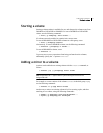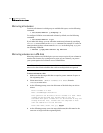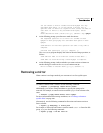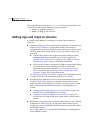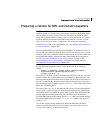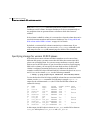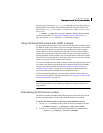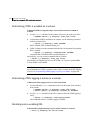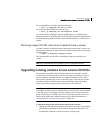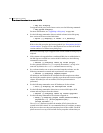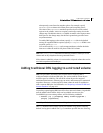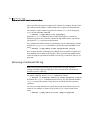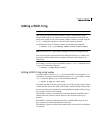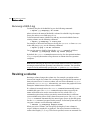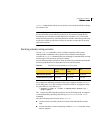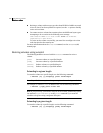
279Administering volumes
Upgrading existing volumes to use version 20 DCOs
To re-enable DRL on a volume, enter this command:
# vxvol [-g diskgroup] set drl=on volume
To re-enable sequential DRL on a volume, enter:
# vxvol [-g diskgroup] set drl=sequential volume
You can use these commands to change the DRL policy on a volume by first
disabling and then re-enabling DRL as required. DRL is automatically disabled if
a data change map (DCM, used with Veritas Volume Replicator) is attached to a
volume.
Removing support for DRL and instant snapshots from a volume
To remove support for DRL and instant snapshot operation from a volume, use
the following command to remove the DCO and DCO volume that are associated
with the volume:
# vxsnap [-g diskgroup] unprepare volume
This command also has the effect of disabling FastResync tracking on the
volume.
Note: This command fails if the volume is part of a snapshot hierarchy.
Upgrading existing volumes to use version 20 DCOs
The procedure described in this section describes how to upgrade a volume
created before VxVM 4.0 so that it can take advantage of new features such as
instant snapshots, and DRL logs that are configured within the DCO volume.
This requires upgrading the version of the disk groups, removing any existing
snapshots and version 0 DCOs that are associated with volumes in the disk
groups, and finally configuring the volumes with version 20 DCOs.
Note: The plexes of the DCO volume require persistent storage space on disk to
be available. To make room for the DCO plexes, you may need to add extra disks
to the disk group, or reconfigure existing volumes to free up space in the disk
group. Another way to add disk space is to use the disk group move feature to
bring in spare disks from a different disk group. For more information, see
“Reorganizing the contents of disk groups” on page 195.
To upgrade an existing disk group and the volumes that it contains
1 Upgrade the disk group that contains the volume to the latest version before
performing the remainder of the procedure described in this section. Use
the following command to check the version of a disk group:



